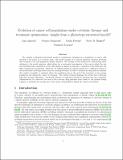Files in this item
Evolution of cancer cell populations under cytotoxic therapy and treatment optimisation : insight from a phenotype-structured model
Item metadata
| dc.contributor.author | Almeida, Luis | |
| dc.contributor.author | Bagnerini, Patrizia | |
| dc.contributor.author | Fabrini, Giulia | |
| dc.contributor.author | Hughes, Barry D. | |
| dc.contributor.author | Lorenzi, Tommaso | |
| dc.date.accessioned | 2019-02-11T11:30:04Z | |
| dc.date.available | 2019-02-11T11:30:04Z | |
| dc.date.issued | 2019-07 | |
| dc.identifier | 255501740 | |
| dc.identifier | 86976ec7-bd99-4b65-bf76-0012ac4c8c67 | |
| dc.identifier | 000475771600001 | |
| dc.identifier | 85069474071 | |
| dc.identifier.citation | Almeida , L , Bagnerini , P , Fabrini , G , Hughes , B D & Lorenzi , T 2019 , ' Evolution of cancer cell populations under cytotoxic therapy and treatment optimisation : insight from a phenotype-structured model ' , ESAIM: Mathematical Modelling and Numerical Analysis (ESAIM: M2AN) , vol. 53 , no. 4 , pp. 1157-1190 . https://doi.org/10.1051/m2an/2019010 | en |
| dc.identifier.issn | 2804-7214 | |
| dc.identifier.uri | https://hdl.handle.net/10023/17034 | |
| dc.description | BDH acknowledges support from the Australian Research Council (DP140100339). LA and TL gratefully acknowledge support of the project PICS-CNRS no. 07688 and the French "ANR blanche" project Kibord: ANR-13-BS01-0004. | en |
| dc.description.abstract | We consider a phenotype-structured model of evolutionary dynamics in a population of cancer cells exposed to the action of a cytotoxic drug. The model consists of a nonlocal parabolic equation governing the evolution of the cell population density function. We develop a novel method for constructing exact solutions to the model equation, which allows for a systematic investigation of the way in which the size and the phenotypic composition of the cell population change in response to variations of the drug dose and other evolutionary parameters. Moreover, we address numerical optimal control for a calibrated version of the model based on biological data from the existing literature, in order to identify the drug delivery schedule that makes it possible to minimise either the population size at the end of the treatment or the average population size during the course of treatment. The results obtained challenge the notion that traditional high-dose therapy represents a 'one-fits-all solution' in anticancer therapy by showing that the continuous administration of a relatively low dose of the cytotoxic drug performs more closely to the optimal dosing regimen to minimise the average size of the cancer cell population during the course of treatment. | |
| dc.format.extent | 2445311 | |
| dc.language.iso | eng | |
| dc.relation.ispartof | ESAIM: Mathematical Modelling and Numerical Analysis (ESAIM: M2AN) | en |
| dc.subject | Cancer modelling | en |
| dc.subject | Therapy optimisation | en |
| dc.subject | Nonlocal parabolic equations | en |
| dc.subject | Exact solutions | en |
| dc.subject | Numerical optimal control | en |
| dc.subject | RC0254 Neoplasms. Tumors. Oncology (including Cancer) | en |
| dc.subject | 3rd-NDAS | en |
| dc.subject | SDG 3 - Good Health and Well-being | en |
| dc.subject.lcc | RC0254 | en |
| dc.title | Evolution of cancer cell populations under cytotoxic therapy and treatment optimisation : insight from a phenotype-structured model | en |
| dc.type | Journal article | en |
| dc.contributor.institution | University of St Andrews. Applied Mathematics | en |
| dc.identifier.doi | https://doi.org/10.1051/m2an/2019010 | |
| dc.description.status | Peer reviewed | en |
This item appears in the following Collection(s)
Items in the St Andrews Research Repository are protected by copyright, with all rights reserved, unless otherwise indicated.

